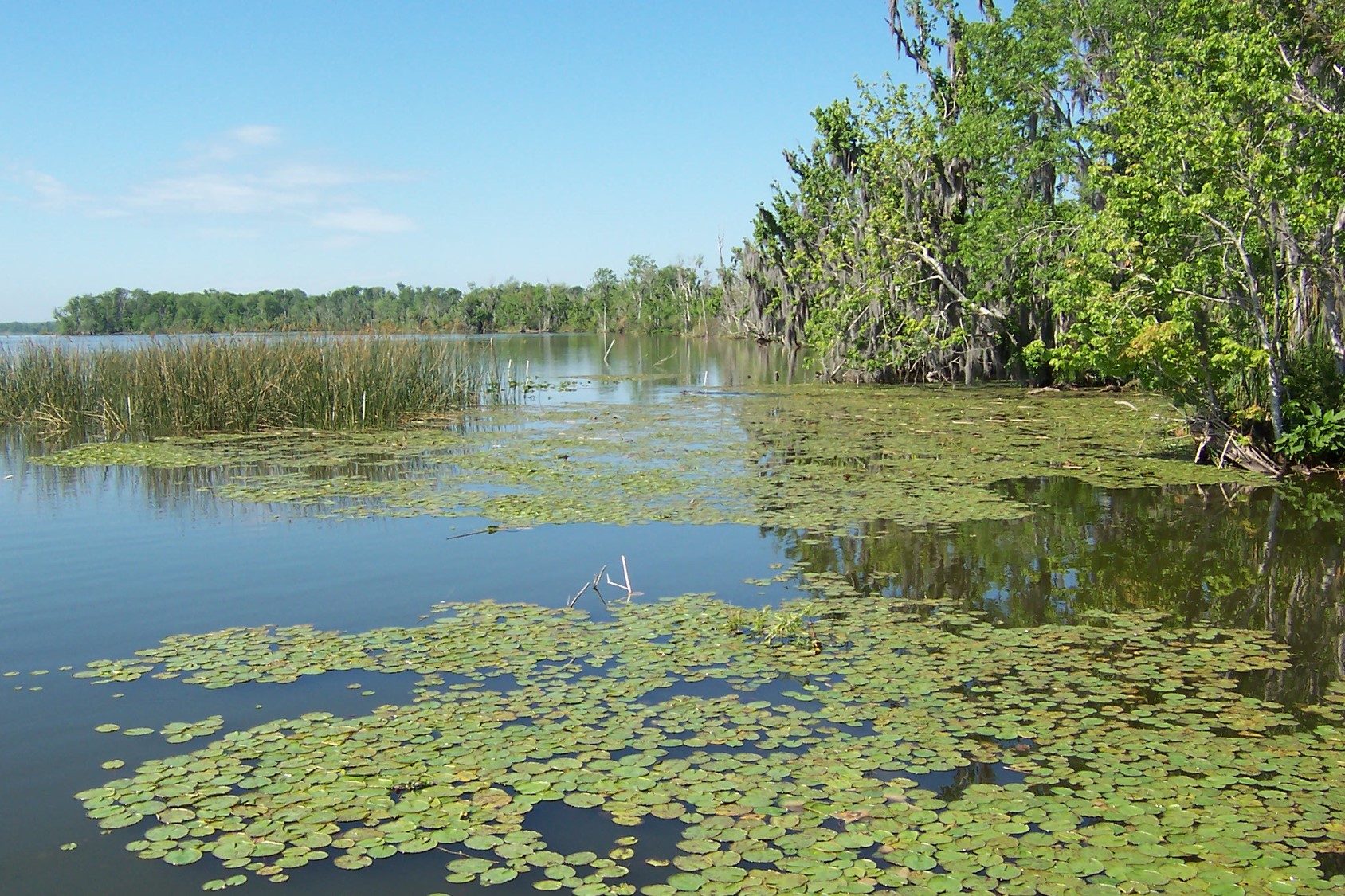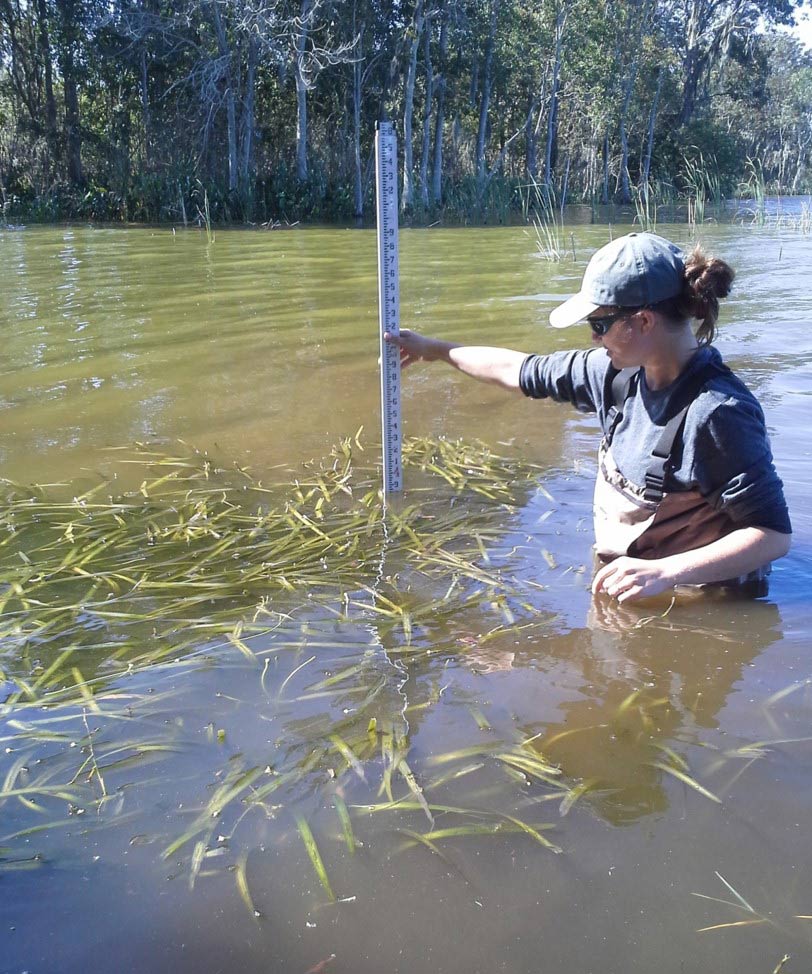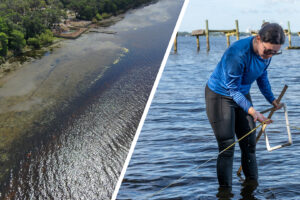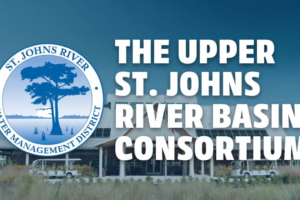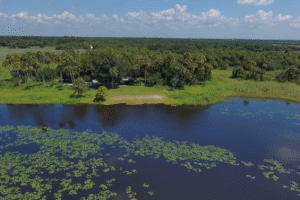Aquatic plants tell us Lake Apopka’s water quality is improving
Until recently, Illinois pondweed (Potamogeton illinoensis), a Florida native aquatic plant, hadn’t been seen in Lake Apopka for 50 years. For decades, it had been difficult to see much of anything in what was once called Florida’s most polluted large lake.
Today, St. Johns River Water Management District scientists say the agency’s ambitious multi-faceted restoration projects are returning Lake Apopka to its status as central Florida’s original tourist attraction. One critical indicator, they say, is the recovery of the lake’s submerged aquatic vegetation (SAV).
“Before the 1950s, submerged aquatic vegetation used to be prolific throughout the lake,” says Jodi Slater, one of the District’s environmental scientists whose work focuses on the lake’s plant life. “Water quality in Lake Apopka has improved enough to the point that SAV was naturally returning and now we are able to reintroduce additional submerged aquatic plant species, like the extirpated (locally extinct) Illinois pondweed, to further accelerate the lake’s recovery.”
To understand the significance of Slater’s statement is to know Lake Apopka’s comeback story. Located in northwest Orange and southeast Lake counties, the 30,800-acre lake is the headwaters of the Ocklawaha Chain of Lakes. Through the 1940s, Lake Apopka was one of central Florida’s main attractions. More than 20 fish camps ringed the lake, welcoming anglers from throughout the United States to fish for trophy-sized bass.
Lake Apopka’s decline can be traced to several changes dating back to the 1890s when construction of the Apopka-Beauclair Canal lowered lake levels by a third. The lower water levels allowed sediments to remain stirred up in the water for longer durations, reducing water clarity. However, the most harmful change began in the 1940s, when the lake’s large northern floodplain was diked off from the lake and drained and put into agricultural production on the newly exposed rich organic soils. The farms pumped agricultural discharges into Lake Apopka, overloading it with nutrients for the next 50 years. In addition, treated wastewater discharged from shoreline communities and citrus processing plants prior to the 1980s.
Jim Peterson, a District field program supervisor involved in Lake Apopka water quality and monitoring projects for the past 26 years, remembers when the lake looked like “fluorescent pea soup.”
“Now, Lake Apopka is still a little green, but the transparency is much better than it was, even compared to a few years ago,” he says.
Slater and Peterson say that 1995 marked a small but significant turning point.
“In 1995, we found a patch of submerged aquatic vegetation in the lake,” Slater says. “Now we have an estimated 209 acres of submerged aquatic habitat lakewide.”
Over the decades, the District has worked diligently to eliminate harmful nutrient-laden discharges into Lake Apopka. However, the key was the 1996 Legislature’s decision to direct the District to purchase the north shore farms and manage the area to reduce phosphorus runoff to the lake. This process has focused on restoring the area’s former wetlands, essentially putting the lake on a phosphorus diet. Construction of additional projects is underway that will further reduce phosphorus inputs to the lake.
“In addition to the phosphorus diet, we’ve implemented projects that remove excess phosphorus from the lake in the same way exercise removes excess fat,” says Dr. Erich Marzolf, director of the District’s Division of Water and Land Resources. “Two key exercise projects are the marsh flow-way, a recirculating 670-acre wetland that filters sediments and nutrients from the lake’s water; the other is the removal of millions of pounds of gizzard shad, a fish that contributes to nutrient recycling by stirring up bottom sediments during their feeding.”
Through the end of 2019, the marsh flow-way alone has removed 65,174 pounds of phosphorus, 130,617,645 pounds of suspended solids and 2,312,493 pounds of nitrogen from the lake. The shad harvest, begun in 1993, has removed more than 28 million pounds of fish with the simultaneous removal of 231,020 pounds of phosphorus.
Once the District’s many water quality improvement projects began to take hold on the lake, District scientists knew planting native aquatic plants would help heal Lake Apopka more quickly.
“Submerged aquatic plants take in the nutrients and allow solids in the water to settle,” Slater says. “As the water becomes clearer, the submerged plants can spread at a faster rate. As their coverage increases, nutrient intake increases, more suspended solids settle out and the lake improves more quickly.” SAV is also important because it is the critical habitat for many sport fish species and is the habitat needed to recover the lake’s past glory as a bass fishery.
Over the years, the District has partnered with the Florida Fish and Wildlife Conservation Commission and the University of Florida (UF) on projects to reestablish submerged vegetation and emergent floating vegetation, such as cow lilies and white water-lilies. Results were mixed in the early days, Slater says.
In 2011, as water quality continued to improve in Lake Apopka, the District launched a more organized effort to hunt and map submerged aquatic vegetation using GPS technology. Plant growth was so prolific that by 2017, the District converted to a completely random sampling method to monitor and measure growth each year at more than 110 sites randomly scattered throughout the lake and to provide an annual lakewide estimate of coverage.
“Instead of little patches of plants they’re growing into each other,” Peterson says. “It’s a spectacular milestone to see the plants spreading across the bottom of the lake.”
It’s a spectacular milestone to see the plants spreading across the bottom of the lake.
The improved water clarity in Lake Apopka isn’t just speculation. Average water transparency is up 55 percent over the past four years compared to the 1989–94 averages, while total phosphorus concentrations are down 64 percent, chlorophyll-a concentrations, a measure of the abundance of algae, has dropped by 58 percent and total nitrogen concentrations are down 44 percent.
“We’ll use the recommendations from UF to conduct a larger-scale planting effort over the next two years,” Slater says. “We’re still struggling with establishing plants in the deeper water because of the lack of light that they need to survive. It’s just going to take time.”
Most of the submerged aquatic plants are slowly spreading on their own, but the District is partnering with UF researchers on a large-scale project to determine approaches that can maximize restoration planting efforts to supplement the natural expansion. UF is exploring which species, growing techniques and locations could support plants to identify information to use in restoration planting efforts to possibly speed up the plants’ recovery throughout Lake Apopka.
“The increase in submerged aquatic vegetation is a clear indicator of improving water quality in Lake Apopka,” Peterson says. “The lake isn’t restored yet, but we’re getting there.”


